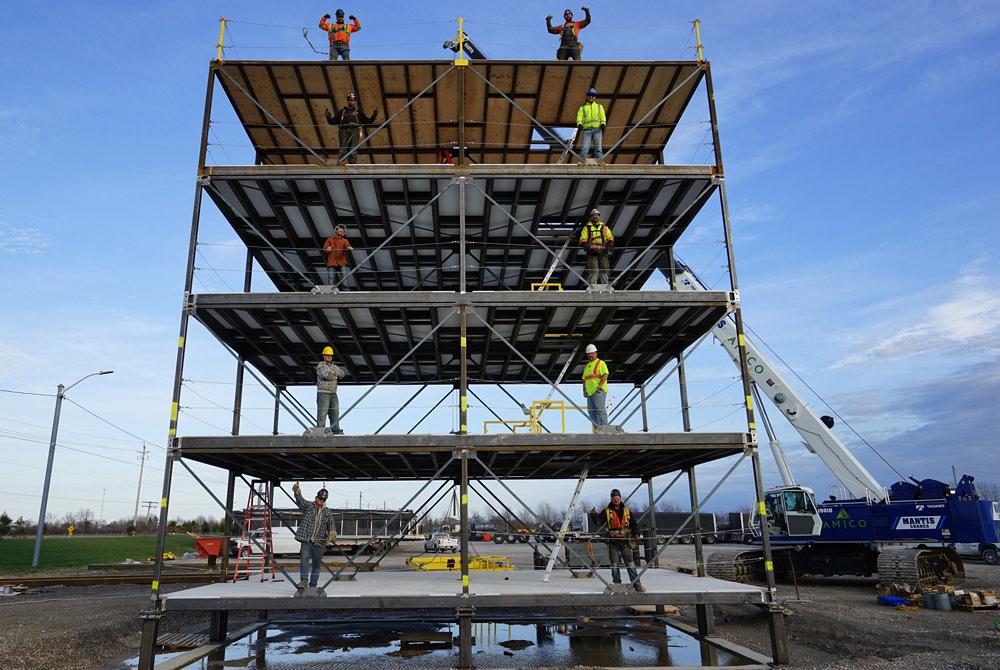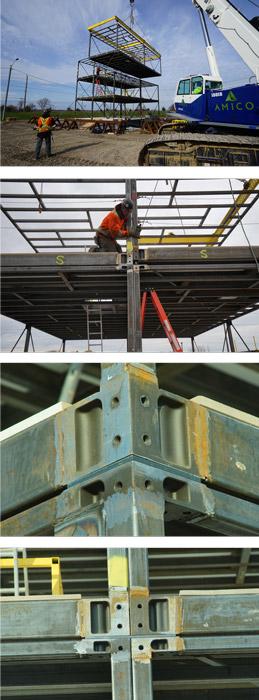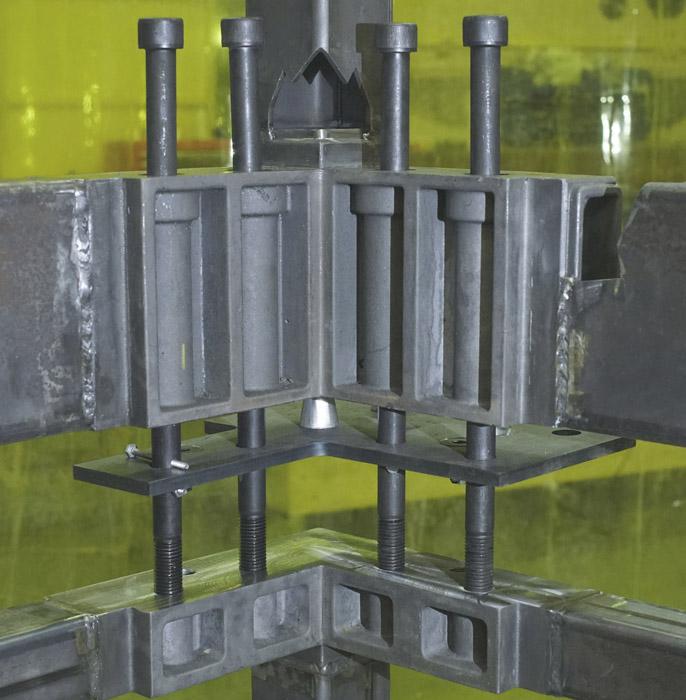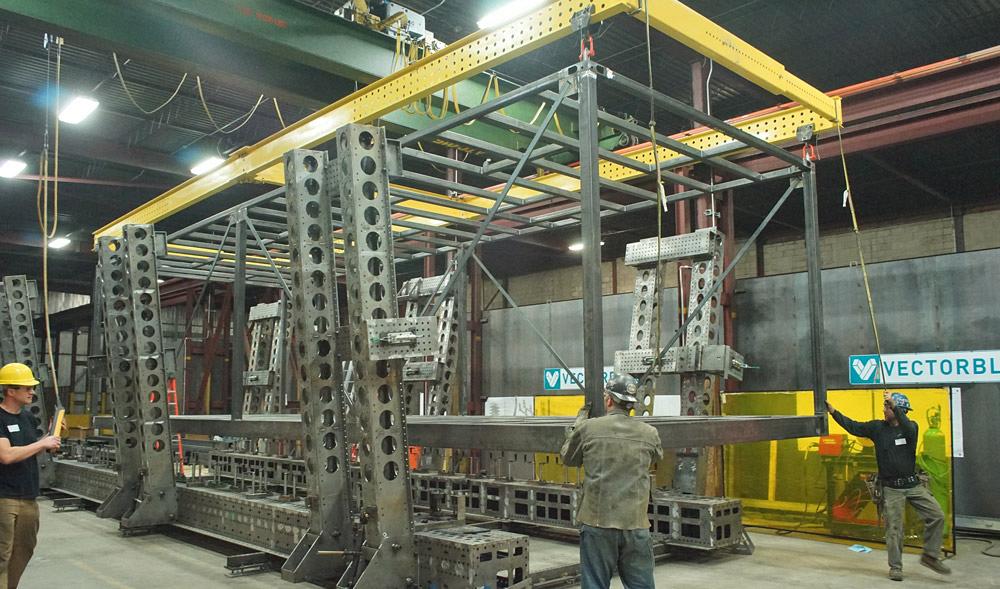Senior Editor
- FMA
- The Fabricator
- FABTECH
- Canadian Metalworking
Categories
- Additive Manufacturing
- Aluminum Welding
- Arc Welding
- Assembly and Joining
- Automation and Robotics
- Bending and Forming
- Consumables
- Cutting and Weld Prep
- Electric Vehicles
- En Español
- Finishing
- Hydroforming
- Laser Cutting
- Laser Welding
- Machining
- Manufacturing Software
- Materials Handling
- Metals/Materials
- Oxyfuel Cutting
- Plasma Cutting
- Power Tools
- Punching and Other Holemaking
- Roll Forming
- Safety
- Sawing
- Shearing
- Shop Management
- Testing and Measuring
- Tube and Pipe Fabrication
- Tube and Pipe Production
- Waterjet Cutting
Industry Directory
Webcasts
Podcasts
FAB 40
Advertise
Subscribe
Account Login
Search
Structural tube fabrication: Getting a solid connection for HSS
Precise fabrication shortens modular building erection to mere hours
- By Tim Heston
- February 1, 2016
- Article
- Tube and Pipe Fabrication

Figure 1
This “test stack,” built in November 2015 in the yard of JMC Steel Group’s Atlas Tube mill in Harrow, Ont., showed how quick modular construction can be. Two interconnected stacks of four chassis, all made of HSS, were erected in four hours.
One morning during the last week of November 2015, in the coil inventory yard of JMC Steel Group’s Atlas Tube mill in Harrow, Ont., a team erected a modular four-story building frame of steel hollow structural sections, or HSS. They finished by early afternoon.
This wasn’t a typical construction project. The team was from Vector Praxis, which used a crane from Connexio Building Systems Inc., a module outfitter and erector launched last year by a partnership between JMC Steel Group and Amico Affiliates, a construction firm in Windsor, Ont. To construct the building, the team used Vector Praxis’ VectorBloc system. Connexio now is the first licensee of that technology.
Julian Bowron, Vector Praxis’ founder and president, hopes this technology will overcome the challenges of modular building with HSS. According to Bowron, the system provides a way to connect HSS quickly and accurately in the fab shop (see Figure 1). This, he said, is what allowed the team to build a four-story steel frame in four hours.
A Connection Challenge
From a purely physics perspective, hollow structural sections have numerous advantages, one being strength. By moving the material away from the center of the section (as with a typical hot-rolled beam) toward the periphery, HSS have a high strength-to-weight ratio.
But from an engineering perspective, wide-flange beams have had one main advantage: They’re easy to connect. To assemble angles and beams, an erector simply bolts through two adjacent flanges, or he bolts through a clip into a web section.
“Do that, and you get the slip-critical connection everybody wants,” Bowron said. “But connecting to HSS can be challenging. How do you attach a nut? If you try to fabricate connection points out of pieces of plate, then you’re going back more than a century,” back before the wide-flange beam was in common use, when individual plates were riveted together to make structural beams.
This is where steel cast connections fill a need. Several North American companies have developed connection systems for HSS, including ConXtech in California and CastConnex in Ontario. Vector Praxis has focused its connection system on the modular building market.
Challenges of Modular Construction
“Having been in structural engineering for a number of years, I knew that ‘modular construction’ was a buzzword that had been around for a long time,” said Brad Fletcher, sales engineer at JMC Steel’s Atlas Tube. “But there have always been stumbling blocks. The execution was always a tough nut to crack. But when I looked at [Bowron’s] concept, I couldn’t poke any holes in it.”
Modular construction often entails outfitting certain elements of the building like bathrooms—installing the plumbing, electrical, toilets, and the rest—on a shop floor, then trucking these pods to the construction site. There, the pods are hoisted into place within a steel frame.
But according to Fletcher, the nature of the VectorBloc system, including the tight-tolerance fabrication involved, may expand the possibilities of modular construction. Instead of constructing pods and sliding them into a frame built on-site, the steel frame itself is broken up into chassis, or cubical (or rectangular prism) steel frames, which can be fabricated in the controlled shop environment. Each chassis then is outfitted into a complete module with flooring, electrical, HVAC, sprinkler systems, tiles, and even drywall and the building façade.
“That’s the pipe dream,” Fletcher said. “You stack these, and you end up with a completed building that’s plug-and-play. We think VectorBloc will give someone the opportunity to achieve that pipe dream.”
About Accuracy
The idea for the Vector Praxis system came in part from connection systems used on container ships. Containers aren’t simply placed on top of each other without a secure connection (lest a lot of containers fall overboard). Instead, they have steel cast connectors on each corner. To join these container corners requires access from the outside, which doesn’t make them practical for modular construction, especially if façade panels are already in place.
“Still, [the containers] don’t touch anywhere else,” Bowron said. “If you look at an oceanic freight container, all the forces get transmitted through those corners. That really was the inspiration.”
The weld prep on the end of the VectorBloc fits into the end of the HSS, and a weld secures the connection (see Figure 2). In the plant, fabricators weld and assemble the HSS into a chassis, a steel frame that is then outfitted into complete modules, ready to be transported to the construction site and hoisted onto the structure. Workers stack modules at the connectors located at the corners as well as at intermediate points if loading conditions require it (see Figures 3 and 4). It’s a little like building with LEGO® blocks, just on a massive scale.
What makes LEGO such a fun and successful toy isn’t just the design of the blocks themselves. It’s the fact that all snap together precisely, with little fuss. The same holds true for the cast connections for HSS.
“What if you started to build a wall of LEGOs, and yet you found all the bricks were slightly different,” Bowron said. “It wouldn’t be a fun toy anymore … Similarly, imagine if a production line worker at General Motors placed a door in an opening, then had to take the door off and grind it down to size so it can fit satisfactorily. The entire industry would fall apart. And yet it’s widely accepted to this day in the structural steel industry that the building is beaten into shape as you go. There’s a constant swarm of surveyors on every project.”
Accuracy is critical in modular construction. A small positioning error on the bottom of a building can turn into a major error dozens of stories in the air. Bowron gave an example of a 10-story apartment building. If the bottom module is short just 1⁄16 inch, by the 10th story this error adds up to 10⁄16, or a little less than ¾ in. The adjacent stack has a bottom module that’s 1⁄16 in. too tall. By the 10th floor, the module is almost ¾ in. too tall. “Now you’ve got a 1.5-in. bump in the floor between the adjacent stacks of modules,” he said. “Obviously, that’s unacceptable.”
So erectors have resorted to various workarounds. They often shim and adjust the modules as they stack them. And they sometimes put a layer of concrete between the modules to hide the positioning errors.
“All this negates the principal benefit of modular building,” Bowron said. Why fabricate modular components if workers need to spend a lot of time shimming and adjusting on the job site?
He added that GM and other assembly OEMs avoid this simply by using go/no-go gauges. If a door or any other component doesn’t fit the gauge, it doesn’t make it to the assembly line in its current condition.

Figure 3
Cranes lift modular chassis into place, and workers position the connection points at the corners.
The same concept now has been carried over to the structural fabrication of modules of HSS, using what Vector Praxis calls the VectorJig (see Figures 5 and 6).
Think of it as a giant go/no-go gauge, large enough to hold an entire chassis. It’s built using laser measuring systems to ensure the entire chassis assembly stays well within tolerance.
“The chassis locating features are ±-0.015 in., while our connection plates, or gusset plates, allow for ±0.030 in.,” Bowron said. “That is about the thickness of two business cards.”
The jig also makes structural fabrication automation a lot easier to integrate. Some of the latest systems use touch probes and other sensing systems to account for positioning variability. The jig reduces that variability and, in turn, the need for welding touch probes or vision systems.
“You can only implement robotic welding if you know where the weld is,” Bowron said. “There are intelligent systems that allow the robot to find a seam and lay a bead, but it’s far easier to predictively locate that weld in 3-D space.”
From Coil to Building Frame
Bowron has had a lot of exposure to the challenges of modular building within the past five years. He previously launched and operated a modular structural fabrication plant, which he then sold to the Walters Group, a large architectural and structural fabricator based in Hamilton, Ont.
In 2011 Bowron launched Vector Praxis as a high-end architectural detailing and fabrication operation, using building information modeling (BIM) and precision, large-scale jigs. In 2014 the company introduced its VectorBloc concept, and in 2015 Bowron met with JMC Steel Group CEO Barry Zekelman as well as Fletcher. The company decided to buy a stake in Vector Praxis, giving the organization the cash infusion it needed for tooling and further research and development, including the four-story “test stack” erected that one morning in November. During the following weeks, workers began tearing the test stack apart, pulling it, pushing it, compressing it, and subjecting it to all manner of destructive testing.
The chassis was fabricated by VectorBloc staff in Atlas Tube’s mill in Harrow, Ont., near Windsor. According to a Vector Praxis presentation, “Atlas Tube’s Harrow mill is the only place in the world where steel coil is converted into volumetric modular building chassis under one roof.”
For the test stack, Atlas Tube’s Harrow plant started with the coil material (see Figure 7), which was leveled, formed, welded, and cut into HSS of the appropriate shape and length. A team from Vector Praxis then fabricated the HSS into eight chassis. They were then sent to the Harrow plant’s inventory yard, where a Vector Praxis crew erected the steel frames within hours.
After this, the team turned the responsibility of chassis fabrication over to a new business entity called VectorBloc Fabricating (VBF), co-located with the Atlas Tube mill in Harrow. VBF is a joint venture between Vector Praxis’ VectorBloc Corp. (the legal entity that owns the intellectual property behind the VectorBloc) and JMC Steel’s Atlas Tube.

Figure 4
This cutaway of a VectorBloc connection shows how the cast components bolt the HSS together, sandwiching a gusset plate in between the upper and lower blocks. The weld prep on the end of the block fits into the end of the HSS, and a weld secures the connection.
In December, VBF started the work on the chassis for a 140-unit retirement home. Chassis will be shipped to the Connexio plant in Windsor for outfitting before being sent to the job site for erection.
“Now we have a backlog of a little more than 500 modules at this point,” Bowron said. “A lot of people were waiting for the test stack, our proof of concept, to be completed. We expect a lot of new interest in the first quarter [of 2016.]”
The test structure erected in November may be a harbinger showing just how quickly a building can be constructed. Not long before, the HSS in that four-story frame were in their raw form—as steel coils.
Images provided by Vector Praxis Inc., 220 Humbercrest Blvd., Toronto, ON M6S 4L3 Canada, 416-766-9018, www.vectorpraxis.com.
Amico Affiliates, 519-737-1577, www.amicoaffiliates.com
Atlas Tube, JMC Steel Group, 800-733-5683, www.atlas tube.com
Connexio Building Systems Inc., 519-800-0010, www.connexiobuilding.com
About the Author

Tim Heston
2135 Point Blvd
Elgin, IL 60123
815-381-1314
Tim Heston, The Fabricator's senior editor, has covered the metal fabrication industry since 1998, starting his career at the American Welding Society's Welding Journal. Since then he has covered the full range of metal fabrication processes, from stamping, bending, and cutting to grinding and polishing. He joined The Fabricator's staff in October 2007.
Related Companies
subscribe now

The Fabricator is North America's leading magazine for the metal forming and fabricating industry. The magazine delivers the news, technical articles, and case histories that enable fabricators to do their jobs more efficiently. The Fabricator has served the industry since 1970.
start your free subscription- Stay connected from anywhere

Easily access valuable industry resources now with full access to the digital edition of The Fabricator.

Easily access valuable industry resources now with full access to the digital edition of The Welder.

Easily access valuable industry resources now with full access to the digital edition of The Tube and Pipe Journal.
- Podcasting
- Podcast:
- The Fabricator Podcast
- Published:
- 04/16/2024
- Running Time:
- 63:29
In this episode of The Fabricator Podcast, Caleb Chamberlain, co-founder and CEO of OSH Cut, discusses his company’s...
- Trending Articles
How to set a press brake backgauge manually

Capturing, recording equipment inspection data for FMEA

Tips for creating sheet metal tubes with perforations

Are two heads better than one in fiber laser cutting?

Hypertherm Associates implements Rapyuta Robotics AMRs in warehouse

- Industry Events
16th Annual Safety Conference
- April 30 - May 1, 2024
- Elgin,
Pipe and Tube Conference
- May 21 - 22, 2024
- Omaha, NE
World-Class Roll Forming Workshop
- June 5 - 6, 2024
- Louisville, KY
Advanced Laser Application Workshop
- June 25 - 27, 2024
- Novi, MI




























